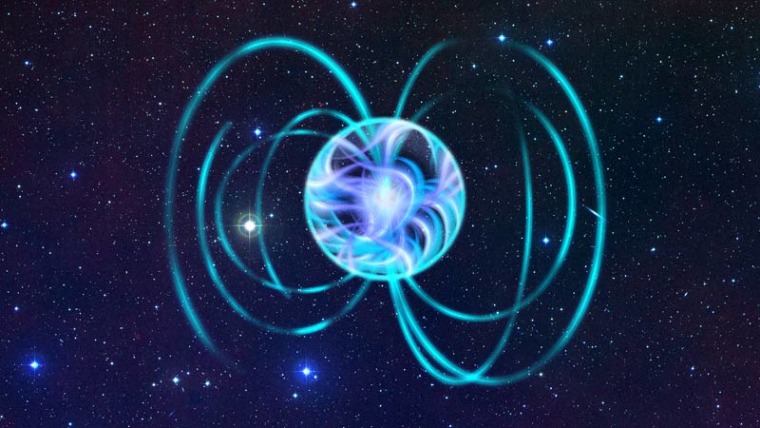In the grand theater of the cosmos, a powerful entity known as a magnetar recently stole the spotlight. After a decade of radio silence, XTE J1810-197, a city-sized neutron star with a magnetic field billions of times stronger than anything on Earth, roared back to life in late 2018.
This stellar reawakening was a tempestuous affair, a violent twisting and snapping of its magnetic field that unleashed a torrent of energy in the form of gamma rays, X-rays, and radio waves.

Magnetars: The Enigmatic Cosmic Monsters
Magnetars are a rare breed of celestial objects, born from the fiery death throes of massive stars. They are essentially neutron stars, the collapsed cores of these giants, but with a twist – their magnetic fields are mind-bogglingly strong. As these fields decay, they exert immense pressure on the magnetar’s outer crust, eventually causing it to crack. This fracturing unleashes a colossal burst of energy, the very event that astronomers were lucky enough to witness with XTE J1810-197.
A Radio Lullaby Turns into a Roaring Symphony
XTE J1810-197 wasn’t always radio silent. Astronomers first discovered it in 2003 as a bright source of X-rays following an outburst. It also emitted radio waves in distinct pulses with a rotation period of 5.54 seconds. However, this radio emission faded rapidly, leaving the magnetar silent for over a decade. Then, in December 2018, astronomers observed a resurgence – XTE J1810-197 was once again a beacon in the radio spectrum.
A Global Collaboration to Unveil the Mystery
This cosmic reawakening sparked an international effort. Three of the world’s largest radio telescopes – the Effelsberg telescope in Germany, the Lovell telescope in the UK, and Australia’s very own Parkes radio telescope – trained their sights on XTE J1810-197. This coordinated observation campaign aimed to capture the evolution of the radio emission in unprecedented detail.
A Wobbly Awakening: A Scarred Surface Revealed
The newfound radio pulses from XTE J1810-197 were highly polarized, wiggling in a specific direction. By meticulously measuring this polarization, astronomers were able to determine the orientation of the magnetar’s magnetic field and spin axis relative to Earth. But they discovered something even more remarkable – the star’s spin wasn’t quite stable. It exhibited a slight wobble, and by comparing this wobble to simulations, astronomers concluded that the outburst had left the magnetar’s surface slightly lumpy, deviating from a perfect sphere by a mere millimeter. Thankfully, this wobbling subsided within three months of the outburst.
Twisted Light: A Challenge to Existing Theories
The radio emission from XTE J1810-197 also revealed another surprise – an unusually high amount of circular polarization. Normally, magnetars only emit very faint circularly polarized radio waves. This observation hinted at complex processes at play within the superheated soup of particles swirling around the magnetar’s magnetic field. Notably, astronomers also observed a phenomenon called “linear-to-circular conversion,” where linearly polarized radio waves were transformed into circularly polarized ones. While this effect was predicted theoretically, the observed behavior didn’t quite match the predictions. This discrepancy highlights the limitations of our current understanding and underscores the need for more sophisticated models to describe radio wave propagation in such extreme environments.
A Stepping Stone to a New Era of Magnetar Research
The observations of XTE J1810-197 mark a significant leap forward in our study of radio-loud magnetar outbursts. By piecing together the evidence – the wobble, the circular polarization, and the outburst itself – astronomers can now paint a more comprehensive picture of these energetic events. The wobble holds promise for testing theories of matter behavior at densities beyond anything achievable in Earthly labs. It’s like having a natural laboratory in the cosmos, pushing the boundaries of physics by subjecting matter to unimaginable forces. The discrepancy in the linear-to-circular conversion phenomenon, on the other hand, compels us to refine our understanding of how radio waves interact with the powerful magnetic fields of these celestial behemoths. It’s a reminder that there’s still so much to learn about these exotic objects, and future observations may reveal entirely new physical processes at play.
The Future Beckons: Unveiling the Secrets of Stellar Beasts
While XTE J1810-197 has settled down for now, astronomers remain vigilant. With ongoing upgrades to telescopes around the globe, the scientific community is better equipped than ever to capture the next time a magnetar awakens.
These observations will provide invaluable insights into the behavior and evolution of magnetars, shedding light on the extreme physics at play within these enigmatic objects. As our understanding grows, so too does our ability to anticipate and prepare for the rare but powerful events they unleash. In the dynamic landscape of astrophysics, each observation brings us closer to unraveling the mysteries of the universe’s most magnetic and energetic phenomena.



















